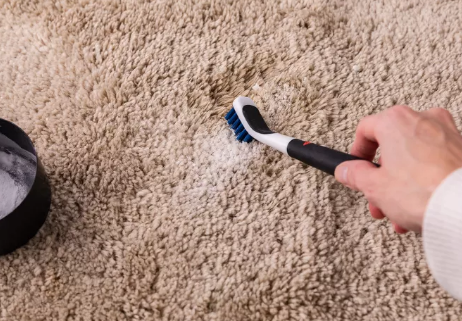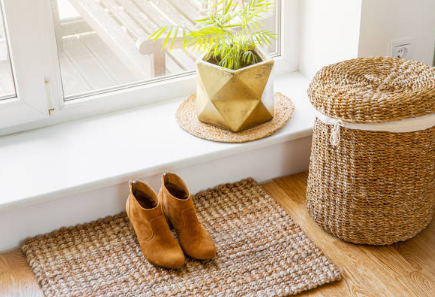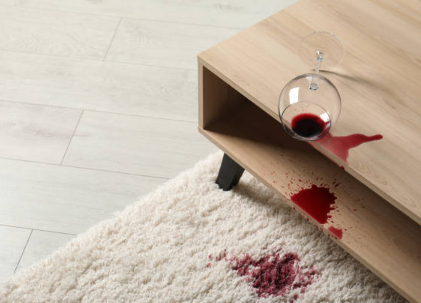
Add Warmth and Personality to Your Kitchen with Runners
December 24, 2023
Tips for Using Small Rugs on Carpet
January 8, 2024Carpets are often infested by shoes, spills, and pets. Whether it’s a full carpet or a small piece of rug, it needs to be cleaned eventually.
There are dozens of carpet cleaning products and hundreds of professional carpet cleaning services on the market.

However, with just a few supplies you may already have, you can clean your carpet yourself with an effective homemade carpet cleaner.
While waiting for your carpet to dry, be prepared to use some elbow grease and some patience.
What You’ll Need

Equipment/Tools
- 1 Plastic bucket or basin
- 2 Spray bottles
- 1 Soft bristle nylon brush
- 4 Microfiber cloth
- 1 Vacuum
- 1 Carpet cleaner
- Stovetop or microwave
- Funnel
- Kiku-ko-hsien
Material
- 1 Steamed water
- 1 Distilled white vinegar
- 1 Dishwashing liquid
- 1 Baking soda
- 1 Salt
- 1 Oxygen bleaching powder
- 1 Labels
How to Make Your Own Carpet Stain Remover
01. Mix the Ingredients

In a spray bottle, mix a cup of distilled water, a cup of distilled white vinegar, and a teaspoon of dishwashing liquid. Shake well and label the bottle.
02. Spray Stains

Spray the solution on the stained area of the carpet and use a soft-bristled brush to brush it into the fibers.
Allow the solution to act for at least 10 minutes to begin to break down the stain.
Tip: Dispose of the stain as soon as it occurs. Suck up as much liquid as possible from the spill. Use a blunt knife or spoon to remove solids that have fallen onto the carpet. Never rub as this will allow the stain to penetrate deeper into the fibers.
03. Rinse, Blot and Dry

Soak the microfiber cloth in cold water and wring it out until moist. Rinse dirty areas of carpets.
When the stain is transferred, continue to move to the clean side of the cloth.
Wipe the area with a dry cloth until there is no more liquid transfer. You can also place a dry towel under weights like books to help absorb moisture faster.
Allow the area to air dry. Do not walk until the area is dry. This can take up to 24 hours.
How to Make Your Own Carpet Freshener
Make a dry mixture that can be used to freshen, deodorize, and brighten carpets.
01. Mix the Ingredients

In a bowl or bucket, mix equal parts baking soda and table salt. To clean a 5 x 7 rug, you need at least one cup of each rug. Mix more carpets.
Fill the spray bottle with distilled water.
02. Dispose of Stains and Vacuum

Treat any visible stains with a stain remover and vacuum loose dirt from the carpet.
03. Spray, Spray and Scrub

Sprinkle the baking soda mixture evenly over the carpet. Working in the grid so you don’t miss any areas, gently spray the dry mixture with water.
Use a soft-bristled brush to brush the mixture into the carpet fibers.
04. Drying and Vacuum

Allow the damp mixture to remain on the carpet until it is air-dried. This can take up to eight hours. Use a vacuum cleaner to remove loose soil and odors.
How to Make Your Own Carpet Cleaning Solution
01. Hot Water

Heat enough distilled water in the stovetop or microwave so that it almost fills the water tank (about a gallon) of carpet cleaner. The water should be hot but not boiling.
02. Mix Cleaning Ingredients

In a plastic bucket, mix half a cup of distilled white vinegar, a tablespoon of dish soap, and a quarter cup of oxygen bleach powder. Add hot water and stir to combine.
03. Carpet Filler Cleaner

Use a funnel to pour the cleaning mixture into the carpet cleaner. You don’t need to dilute the solution.
If you’re cleaning a large area, mix more batches as needed.
04. Operate the Carpet Cleaning Machine

Follow the manufacturer’s instructions for handling the carpet cleaner. Work slowly and watch out for stains and high-traffic areas.
05. Air-Dry Carpet

Allow the carpet to air dry. Do not walk on the carpet until it is completely dry.
Add a circulating fan to speed up drying, and if you must use the room, place plastic items in the walkway.
How Often to Make Homemade Carpet Cleaner
Commercial carpet cleaning products contain preservatives and stabilizers to extend their shelf life. Since homemade cleaners don’t do this, it’s a good idea to have a fresh solution ready before each carpet cleaning, whether you’re dealing with new stains or doing a deep clean.
Bonus Tips
- Before using any carpet shampoo or stain remover, test it in an inconspicuous place. Dampen the cloth with detergent and wipe on the carpet. Wait at least eight hours for the area to dry and check the color of the carpet. Some dyes are unstable, and the composition may change the color of the fibers, especially the dark ones.
- Before using a homemade cleaning solution in the appliance, check the user guide or website of the carpet cooker or cleaner. It may void the warranty,
- Do not use homemade cleaners in rented equipment to avoid maintenance issues.
Frequently Asked Questions
- Can I use homemade carpet solution in a carpet washer?
The recommended homemade solution can be used with most household carpet cleaners. However, check the manufacturer’s website or user guide to make sure it doesn’t void the original warranty.
- Can homemade carpet cleaner clean upholstery?
Water-based carpet cleaners are safe to use on all interior décor labeled W or WS. Take extra precautions not to oversaturate the seat cushion to prevent problems with excessive moisture.
- Does this DIY solution expire?
Since homemade cleaners do not contain preservatives, it is best to prepare a fresh solution before each stain removal or cleaning of the carpet.



